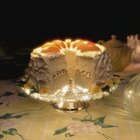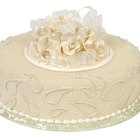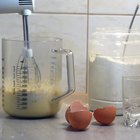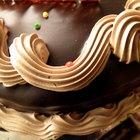
Frosting your cheesecake adds a decorative touch and enhances its delicious flavor. Often, however, the perfect cake cracks while cooling. An easy technique helps you mend the crack and smooth the top of the cake for frosting. Mend first, frost second, then let your guests admire your beautiful dessert and enjoy.
Frosting for Cheesecake
To complement the smooth and delicate flavor of cheesecake, a frequently-used mixture combines sour cream for a little tang with a bit sweetness and is probably the cheesecake topping most similar in consistency to frosting. A sweetened fruit puree or chocolate ganache are also suitable frostings. Like any cake frostings, they look their best on an uncracked surface. Most frostings intended for cheesecake tend to be on the thin or runny side, so you don't need to press down hard with a knife to spread them.
Stabilizing the Cake
Cracks usually happen as a cheesecake cools. Once this process is complete, the first mending step is to chill your cake. Run a knife around the springform pan rim, as you did when you removed the cake from the oven, just to make certain the cake is not sticking to the rim. Then remove the rim. If the crack appears deep or worsens as you remove the pan rim, you might oil a strip of parchment or folded waxed paper, wrap it around the edge of the cake and clip or tape it in place. Oiling will keep the paper from adhering tightly to the cake while letting it support the sides. Some cooks routinely line their pans with an oiled-paper collar before baking. Leave the cake on the spring form pan bottom and chill it in the refrigerator for one to several hours.
Mending the Crack
Boiling water and a narrow, offset spatula are all the mending tools you will need. Fill a bowl or heatproof mixing cup with the water and warm the spatula. Gently move the spatula across the crack, smoothing the edges together. Rinse the spatula in the water, wait until it is warmed again and repeat. It can take just a few or over a dozen gentle strokes to pull the surface of the crack together.
Frosting the Cake
Chill the cake again. If you plan to transfer it from the springform pan bottom to a cake plate or stand, now is the time. Some cooks run a piece of fine string under the entire cake before removing it, so that no stuck parts are left behind. If you made a paper collar, remove it gently once you have the cake settled on its serving dish. Your cake should be completely smooth on top and ready to frost. The mended area may look slightly lighter than the rest of the top, but this disparity will be covered with frosting. Pour and spread your frosting over the cake, using a light touch. Chill it for an additional half-hour to an hour, allowing the frosting to set.
Related Articles

Baking a Cake on Top of Wax Paper

How to De-Pan an Angel Food Cake

How to Fix a Broken Baked Cake

What Is Dirty Icing in Cake Decorating?

How to Cook a Cake in a Pyrex Measuring ...

How to Defrost a Frozen Cake With ...

How to Keep Frosting Moist

How to Freeze Cakes Before Frosting

How to Make a Two-Layered Birthday Cake ...

Do I Need to Refrigerate a Cake ...

Half Sheet Cake Cooling Instructions

How to Ice a Cake With Rice Paper

Cake Pops Recipe with a Galaxy Design

How to Make a Motorcycle Birthday Cake
Freezing a Cake With Buttercream ...

How to Remove a Cake From the Pan
Easy White Cake Recipe

How to Make a Bible-Shaped Cake

How to Make a Cake Board

How to Make a Cruise Ship-Shaped Cake
References
Resources
Writer Bio
Janet Beal has written for various websites, covering a variety of topics, including gardening, home, child development and cultural issues. Her work has appeared on early childhood education and consumer education websites. She has a Bachelor of Arts in English from Harvard University and a Master of Science in early childhood education from the College of New Rochelle.
Photo Credits
Jupiterimages/liquidlibrary/Getty Images